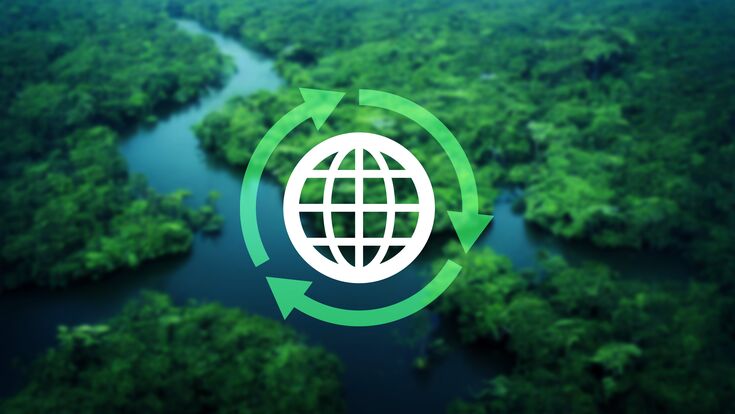Plastic Waste : A Sustainable Future for Plastics? It Must be Circular

When it comes to plastics and sustainability, many outside of the industry would argue that the two are mutually incompatible. In fact, today’s plastics debate is largely seen as black and white, with reduction and eventual phasing out of plastics often touted as the only viable method of minimizing the associated environmental damage.
Plastics, or more specifically single-use plastics, are undeniably causing significant harm to the planet, with the impact of micro- and nano-plastics that do not biodegrade only now being uncovered. However, while reducing the amount of plastic waste in the environment is in everyone’s interests, there remain several significant issues that point to a world that cannot live without them, and while switching from plastic to paper packaging may solve some problems, it also highlights many others.
So, what exactly does the future of the plastics industry look like? And how can plastic use in certain applications be supported without causing unnecessary damage to the environment and human health? Here we look at the plastics problem and how a circular economy will ensure waste is minimized at all stages of production and consumption.
The Plastics Problem
Today, there are many applications and functions that plastics fulfill that simply cannot be fulfilled by other materials. Single-use packaging aside, there are countless applications in the medical, automotive, aerospace, engineering, and construction industries among many others. The problem is, what happens to these and other plastics at the end of their lifecycle.
When considering the future of the plastics industry, we must begin to imagine a circular economy that attempts to keep these materials out of landfill. Whether it’s a single PET water bottle or a PVC medical component, all plastics must be kept in the loop as long as possible, while also being recyclable at the end of their useful life.
This means moving away from single-use entirely, particularly where consumer packaging is concerned, and for those applications where single-use remains a core use-function (such as in PPE, for example) recycling must be easily available and increasingly effective at reclaiming raw materials and recirculating them.
Unfortunately, within existing systems, this is easier said than done. The petrochemical component of conventional plastics is already propping up an oil industry looking to create new revenue streams as the automotive industry moves towards electric vehicles— meaning more plastics manufactured.
Additionally, the recycling industry that plastic producers often cite within plastic sustainability metrics is badly in need of funding and more comprehensive infrastructure, while in many cases, the materials themselves are either non-recyclable or degrade quickly after processing.
Finally, the introduction of PLAs has often been touted as a solution to many of the biodegradability issues caused by conventional petrochemical plastics. However, as monocrop farming continues to be identified as a significant cause of deforestation, a major polluter of both soils and water, and a blight on animal and plant diversity, even this solution is, arguably, a step backwards.
So, a lack of recycling facilities and associated infrastructure, primitive recycling methods, and materials that simply cannot be recycled point to huge sustainability issues for the industry. In fact, in its current state, plastics and sustainability are mutually incompatible, and only through new innovations in materials and recycling technologies can true circularity be achieved.
A Circular Solution to the Plastics Problem
Thankfully, those innovations are now becoming a reality, pointing towards some promising circular solutions for an industry that can transform itself into a leader in sustainability within a small timeframe.
For example, a reduction in common single-use items is already underway, with many consumer brands switching from PET bottles to more sustainable plastic lined paper cartons. While this doesn’t eliminate the problem entirely, it can significantly reduce the amount of plastic in circulation.
Innovations in plastic recycling are also beginning to become a reality. For example, recent advances in pyrolysis have the potential to reduce any type of plastic into oil-like constitute components that can then be used within different products. Apart from the sheer versatility of this base material, this type of recycling also has the added advantage of being “endless”, with little to no degradation or loss of core resources and materials.
Finally, as governments begin to wake up to the scale of the problem, recycling infrastructures and facilities are improving—albeit slowly. This means greater legislation and laws are also being implemented, asking both consumers and businesses to recycle more, and recycle more effectively.
Circular Plastics – The Future
A recent report from the IPCC has painted a stark new outlook for our planet, detailing temperature rises of more than 1.5 degrees in the next 20 years. Unfortunately, the oil industry and the plastics industry remain a large part of the problem, and unless significant changes are made within a short timeframe, the future of plastics look set to remain a destructive thorn in the fight against climate change.
In order for us to justifiably continue our usage of plastics in those areas that simply cannot do without them, the plastics industry needs to take stock and responsibility for its impact and push for greater circularity of materials. The bottom line is, if we cannot live without plastics, then we must find more sustainable ways of producing and recycling it so that it no longer enters the environment as trash or breaks down into microplastics that remain.
Circularity is the answer to these issues, and the plastics industry can become a leader in this field—after all, necessity really is the mother of all invention.
